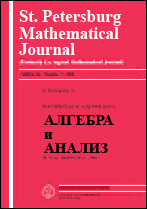|
Research Papers
Free boundary problems via Sakai's theorem
D. Vardakisa, A. Volbergab
a Department of Mathematics, Michigan State University, East Lansing, MI. 48823
b Hausdorff Center for Mathematics, Bonn, Germany
Abstract:
A Schwarz function on an open domain Ω is a holomorphic function satisfying S(ζ)=¯ζ on Γ, which is part of the boundary of Ω. Sakai in 1991 gave a complete characterization of the boundary of a domain admitting a Schwarz function. In fact, if Ω is simply connected and Γ=∂Ω∩D(ζ,r), then Γ has to be regular real analytic. This paper is an attempt to describe Γ when the boundary condition is slightly relaxed. In particular, three different scenarios over a simply connected domain Ω are treated: when f1(ζ)=¯ζf2(ζ) on Γ with f1,f2 holomorphic and continuous up to the boundary, when U/V equals certain real analytic function on Γ with U,V positive and harmonic on Ω and vanishing on Γ, and when S(ζ)=Φ(ζ,¯ζ) on Γ with Φ a holomorphic function of two variables. It turns out that the boundary piece Γ can be, respectively, anything from C∞ to merely C1, regular except finitely many points, or regular except for a measure zero set.
Keywords:
free boundary problems, Schwarz function, real analytic curves, pseudocontinuation, positive harmonic functions, boundary Harnack principle, Nevanlinna domains.
Received: 01.06.2021
Citation:
D. Vardakis, A. Volberg, “Free boundary problems via Sakai's theorem”, Algebra i Analiz, 34:3 (2022), 252–275; St. Petersburg Math. J., 34:3 (2023), 497–514
Linking options:
https://www.mathnet.ru/eng/aa1818 https://www.mathnet.ru/eng/aa/v34/i3/p252
|


| Statistics & downloads: |
| Abstract page: | 159 | | Full-text PDF : | 1 | | References: | 39 | | First page: | 19 |
|





 Contact us:
Contact us: Terms of Use
Terms of Use
 Registration to the website
Registration to the website Logotypes
Logotypes









 Citation in format
Citation in format 